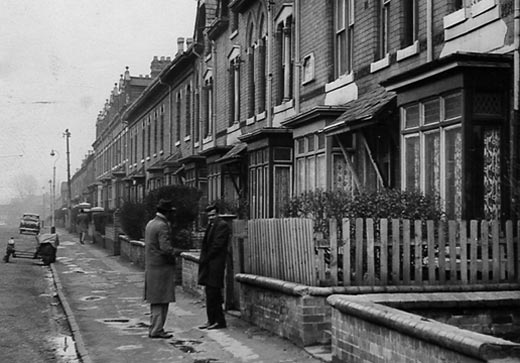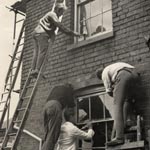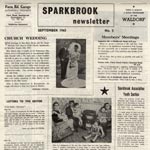
The Housing Crisis
Lodging Houses
Providing Solutions to the Crisis
Directions for Learning
The Housing Crisis
One of the crucial issues resulting from the influx of Commonwealth migrants to Birmingham was housing. During the early 1960s Birmingham suffered from a severe deficit of 30,000 homes and migrants experienced great difficulties in finding somewhere to live. In addition to discrimination by private landlords who displayed signs stating 'No dogs, No Blacks, No Irish', the local authority's housing policy excluded the majority of migrants from council housing since they had to wait 5 years before joining the housing register. In 1967 John Rex and Robert Moore's groundbreaking study, 'Race, Community, and Conflict: A Study of Sparkbrook,' suggested that the housing shortage in Birmingham was a crucial factor behind the growth of 'racial' conflict. Rather than lack of employment it was the waiting list for housing that was the major cause for anxiety about immigration among the local population.
Due to lack of local authority support migrants came to rely on lodging houses in the city's 'twilight zones' for their homes. Twilight zones referred to areas which had fallen into decay but had "not yet reached the night of slumdom". They were characterised by large old houses which had been converted into multi-occupied lodging houses and had become home to migrants. Sparkbrook was one such area.
<return to top>
Lodging Houses
Lodging houses however, provided far from the ideal home. They were severely overcrowded, often lacked bathrooms, and through a combination of neglect and over-use were in a state of decline. Terraces of dilapidated houses, with cracked and broken windows provided homes for the three major groups of migrants to the area- the Irish, West Indians and Pakistanis. A typical example of a lodging house property could be found in Anderton Road where a husband and wife with 3 children rented a large front room, sharing a cooker with 5 other families and a lavatory with 8 other families for £3 per week. Newspaper reports cited some of the worst cases of overcrowding: 40 people were found living in one house and a family of 13 in one room. With an atmosphere of despair and misery, Sparkbrook was portrayed as having a standard of life that was 'Dickensian.' Despite their inadequacies, lodging houses were a 'necessary evil' since they provided a source of accommodation for Birmingham's most socially excluded residents. Unfortunately, because most of the tenants and some landlords were migrants, anti-immigrant sentiment flourished and people attributed poor living conditions to reasons of culture and 'race.'
<return to top>
Providing Solutions to the Crisis
It was within this setting that the Sparkbrook Association attempted to improve living conditions for people in the area. Tackling the housing crisis was a huge task which was beyond the scope of community based organisations. But the Sparkbrook Association did what it could, which was to develop a number of projects to ease some of the problems in the local area.
One of the projects initiated by the Sparkbrook Association was a renovation scheme directed at a number of streets in Sparkbrook which would improve the appearance and condition of properties that had deteriorated. Many properties in Sparkbrook were in an appalling condition. Not only were they overcrowded but they were often in a state of disrepair, with peeling wallpaper, damp, broken windows, holes in the plaster and piles of rubbish littering the back yards. Gladstone Road (shown above), dubbed 'the street of fear' because of disorderly behaviour and prostitution, was the first site for the 'facelift' scheme and was inspired by a similar scheme in Sparkhill. Pakistani landlords were recruited onto 'operation facelift' and openly pledged their support for the scheme. The Secretary of the Commonwealth Property-Owners' Association promised that they would spend £10 for every £5 spent by local residents on improvements. In addition to the facelift scheme, the Sparkbrook Association ran a decorating service for elderly residents who were experiencing difficulties in maintaining their homes. Both local and international students participated in voluntary activities during the summer break, bringing new life to the homes of local people.
Another Sparkbrook Association project involved co-operating with housing associations to address the shortage of quality housing in the area. In collaboration with Birmingham Friendship Housing Association, it ran a scheme which provided flats at an affordable rent to families experiencing particular health and welfare difficulties. The first property was purchased in March 1963 at 10 Anderton Road and was converted and decorated by volunteers. More followed, and around sixteen flats were provided under the scheme. The scheme was guided by the Christian ethos of the housing association which was formed in 1956 by a group of Christians who had "a concern for the immigrant workers and their families who were living in overcrowded and squalid conditions in the city" and this would have resounded with the Christian and Quaker beliefs of many of the Association's members.
Links with the local authority also enabled the Sparkbrook Association to campaign successfully for new street lighting throughout the area.
The Sparkbrook Association initiated some important work that contributed to easing the housing situation in the area however, its contribution was only a small drop in the huge ocean of work that needed to be carried out in relation to solving Sparkbrook's and Birmingham's housing crisis. Important matters such as racial discrimination in the allocation of council housing, finding constructive and unbiased solutions to the Irish Tinker 'problem,' and lobbying for policy change were matters which the Association failed to tackle. This is due in part because of the Association's apolitical stance but also because of its relationship with the local authority. Thus, whilst the Association did collaborate with the local authority to produce a study on the physical, economic and social conditions of the area in 1969- the 'Community Plan' - this stopped short of criticising the council for its shortcomings. Dealing with the housing situation required much more than an organisation like the Sparkbrook Association alone, could manage. Nevertheless, its efforts demonstrate that a difference could be made to individual lives through a number of small scale projects.
<return to top>
Directions for Learning
A number of Friendship Housing's annual reports can be found in Dr Barrow's archive (MS1914/1/5/4.) As well as the type of support on offer you may wish to consider what they tell us about attitudes towards migration and single motherhood during the 1960's.
Travelling communities in particular have continually faced barriers in setting up their homes. Materials in Dr Barrow's archive, the Paul Hill photographic collection and the Charles Parker archive reveal interesting aspects of travelling life and the prejudice faced by travellers. How much can you find out about the history of travelling people in both Birmingham and Britain?
<return to top>
Author: Sarah Dar
Image: copyright Birmingham Post and Mail. Properties on Gladstone Road, 1960s.
[Birmingham City Archives: MS 1914/1/10/72]
|
|

Homes
for Sparkbrook

Highlighting
Housing Need
|